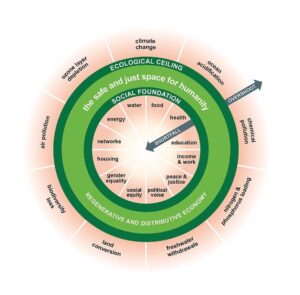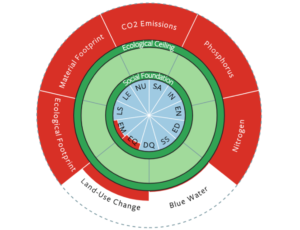Why Doughnut Economics could be a better model for local economies
Doughnut Economics is a model to measure progress in an economy by monitoring impacts on the social and planetary boundaries. The Doughnut Economics model is visualized using two concentric circles – the inner circle represents how successfully the economy has fulfilled basic life essentials like water, food, and health, while the outer circle represents how the local economy stays within planetary boundaries and reduces stresses placed on Earth’s ecological systems like the ozone layer, soils, and climate. The space between these circles is considered the ideal place for an economy to be in.
Doughnut economics takes a different approach than the traditional growth model, suggesting that regenerative methods and sustainability, rather than an unending rise in mass production and consumerism, are essential for the future.
Amsterdam, Copenhagen, Melbourne, and California are some of the places that are adopting this framework of doughnut economics to redesign their outlook towards growth.
Focusing locally is a great way to start this framework. Doughnut economics encourages local economies to be self-sufficient and resilient by focusing on fulfilling the well-being of the local community, and it identifies the impact our activities are having on the local ecosystem. Using this framework, local authorities should look at their problems through a regenerative lens and work towards solutions that give back to their local ecosystem. Local authorities should also analyze the economic and ecological impact that imports to the local economy have on the world.
The doughnut economy diagram of the United States above tells us that, on average, the United States has met most of its basic socio-economic needs but at an exceedingly high cost to the planet and its future capability to provide support for the next generation. The red wedges show the shortfall/overshoot of the respective boundaries. The table– below gives a detailed look into the alarming extent to which the planetary boundaries have been pushed and shows why we need to urgently change the course of economic development by adopting sustainable and regenerative methods.
For more information –
https://doughnuteconomics.org/tools-and-stories/14
Doughnut Economics: seven ways to think like a 21st century economist, A book by Kate Raworth
- Why Doughnut Economics could be a better model for local economies - June 16, 2021
- Sustainable Economic Development Models - January 13, 2021


